Sijinn, Elemental Tribes
... an ancient diaspora from beyond the stars, the Living Elementals of Pathon.
"We are vessels of many Elements as sacred embodiments of mind, body, spirit and Soul, coalesced from starlight Wisps and given Life by Divine breath. What we left beyond the broken Gates once divided us across the expanse of Aether, but now, together we can seek the Promised Land. Though many Elements, our Will is united by one Word. We are the Sijinn. This wounded World will become our new Home."
Ancestral Origin & Diaspora
The will to cross the vastness of the Icing Sea in search of the lost Clans became a significant Rite of Passage among the Sijinn. They were given the title Reclaimers; the Izuseiji in the Sijiqon language, and they were expected to return one day. While some perished in the journey, others drifted to the far corners of the World. The Sijinn are commonly known for two migration events- the Sijinn Exodus and Pilgrimages.
The Sijinn Exodus
Exodus as Origin
Exodus as Cycles of Reanimation
Unlike other Cultures, if a Sijinn becomes a Ghost, this occurs within the Spirit, but an Elemental Wraith is an Undead born from the imprinted identity of the Spirit on Source. An Elemental Wraith can inevitably transmute into other terrible forms, such as a Tempest Wraith- a conglomeration of Ghosts or Wraiths contaminated by a singular identity or multiple, seeking control of the storm.
The Sijinn Pilgrimages
Migration from Izeiqor
Sijinn Pilgrims were commonly encountered alone or in a group of two to four.
Culture & Divisions
4 Tribes of the Sijinn
Sijinn Ashasi
Dominate Traits:- Gold / Amber Irises, Glow
- Bronze / Copper Shiny
- Red / Ash Blonde Hair
- Sinewed / Firm Frames
- Bronze/ Coal Irises, Dim
- Obisidian / Charcoal Tan
- Wild Copper/ Gold Hair
- Tall/ Tapered Frames
- Warm Aura, Oily Skin
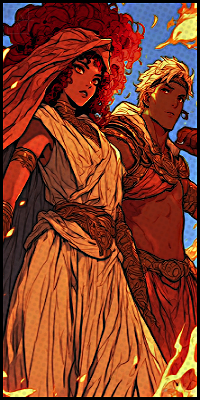
Tribe of Flames
The Ashasi Tribes are the Sijinn of Heat and Fire, masters of the language of Flames. Of the four groups of Sijinn, the Ashasi Tribes adapted most to the Ice Age, often adopting leadership roles among the Sijinn. Brave, ambitious, as quick to action as they are to laugh, and boldly spirited, Ashasi make admirable allies and rivals.Rare Trait: Smoky Breath
A wisp ignites into a spark, A proof of heart against the dark,
Biting embers, we speak our Name, We are the Ashasi of First Flame.
Sijinn Ornosi
Dominate Traits:- As Hair, Carved Eyes
- Earth Clay/ Olive, Soft
- Jade / Purple Hair, Sifts
- Hewn / Angular Frame
- Crystalline Irises, Glassy
- Fossil Wood/ Clay, Hard
- Earth Tone Hair, Dusty
- Broad/ Bulky Frames
- Earthen Bones and Nails
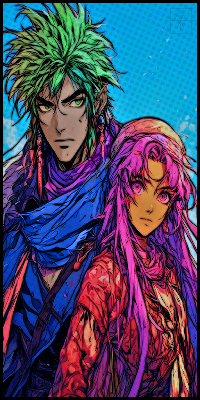
Tribe of Earth
The Ornosi Tribes of Stone are the Sijinn of fabled Earth, keepers of the Words and Runes. Of the four groups of Sijinn, the Ornosi are deeply attached to agriculture, architecture, and plant medicine. Wise, adaptable , and resilient people, Ornosi carvers and scribes shaped the first Sijinn settlements hewn from caverns of stone.Rare Trait: Stony Growths
A wisp recalls forgotten dirt, A husk within the World, inert,
We cast seeds and witness rebirth, We are the Ornosi of First Earth.
Sijinn Rihusi
Dominate Traits:- Blue/ Gold Eyes, Clear
- Sky-Blue/ Pale Blue Skin
- Azure/ Blonde Hair, Floats
- Tall/ Slender Frames
- Pupil-less, Cloudy sclera
- Sun-Kissed/ Dappled Skin
- Smoky Gray/ Lilac Hair
- Round/ Fluffy Frames
- Windstrewn, Aura Breath
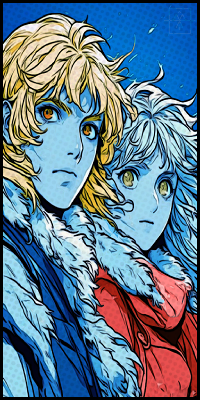
Tribe of Wind
The Rihusi Tribes of Wind are the scries of the skies, watchers of gales and storm, the Sijinn of Air. Of the four tribes of Sijinn, the Rihusi are prone to wanderlust, going where their Spirits lead or traveling often. Cheerful enthusiasts, Rihusi are great musicians and actors that shaped songs, and inspired performance Arts.Rare Trait: Slightly Clear
A wisp breathes and becomes a cloud, A voice rings as it sings aloud,
We echo sound's weight abandoned, We are the Rihusi of First Wind.
Sijinn Talasi
Dominate Traits:- Aqua-Green/ Coral Eyes
- Sea-Green/ Cerulean Skin
- Blue/ Kelp Green Hair, Wet
- Lean/ Stout Frames
- Watery or Glassy Eyes
- Deep Indigo/ Scaly Skin
- Azure/ Coral Hair, Foamy
- Quick/ Liquid Frames
- Amphibious, Slick Skin
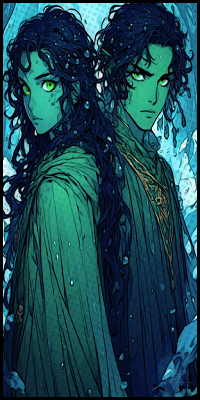
Tribe of Waves
The Talasi Tribe of Waves are the Sijinn of Water, experts on tidal forces and the coastlines. Of the four Tribes of Sijinn, the Talasi were trusted to the secrets of purified Water. They found and forged early river systems, braved the seas, and found employ on sailing vessels often. Fluid and mercurial, Talasi are like tempests in a bottle. Rare Trait: Stretchy Limbs
A wisp dissolves into a mist, A river coursing through a wish,
We drink veins that weep yet saves, We are the Talasi of First Waves.
Sijinn Tribal Relationships
Aligns: Wind- Enjoys company
Opposes: Water- Challenges ideas
Ornosi Tribe (Earth)
Aligns: Water- Provides resources
Opposes: Wind- Grounds in Reality
Aligns: Fire- Follows faithfully
Opposes: Earth- Mischievous pranks
Talasi Tribe (Water)
Aligns: Earth- Active listener
Opposes: Fire- Rejects and isolates
Each Tribe attempted to safeguard common Spell Words, creating new languages.
Kinship Tribes and Sijinn
Bloodlines & Lineages
Sijinn Life Cycles
Age & Lifespan:- Infantile. 3-4 Yrs (5yr)
- Juvenile. 10-15 Yrs (15yr)
- Teenage. 10-15 Yrs (25yr)
- Young Adult. 5-10 Yrs (35yr)
- Adult. 10-15 Yrs (50yr)
- 1st Maturation. 50 Yrs (100yr)
- 2nd Maturation. 200-250Yrs (300yr)
- 3rd Maturation. 300 Yrs (600yr)
- Old Adult. 100-200Yrs (800yr)
- Elder. 100-200Yrs (900yr+)
- Primal. 200-500Yrs (1200yr+)
- Expiration. Occurs around 1500yr
Ancestral Trait: Elemental Blooded
Each Sijinn is attuned to a facet of Source- Earth, Fire, Water, or Wind. Grants one Word. Elemental Blood accesses or limits certain Cultural Items, Spells, Traits, and Talents.
Pairing, Bonding & Separation
In Sijinn Culture, a Male or Female could have several partners. Harems weren't uncommon among the nobility, with pacts regarding Rites of Fertility. However, dissolving a Sijinn Pairing required a notary, tribute, and Rites of Severance, but couples were expected to sort their own ownerships when it came to possessions. Children in custody of a certain age could choose which parents to retain guardianship. Sijinn in a Pairing adopt new names or Clan identities separate from their union, adding a syllable from their partner's Clan name into theirs, changing through the generations.
Language & Expression
Ashen Script
Ornosi Tribe (Earth):
Orren Script
Rihusi Tribe (Wind):
Brihun Script
Talasi Tribe (Water):
Thalen Script
Art, Crafts & Fashion
Philosophy of Harmony
Developed from a common origin, the Sijinn and their Art forms are remarkably similar yet the essence of each individual Tribe preserves each piece. Collectively, the four Tribes of Sijinn enjoyed oratories, and were willing to listen to stories or myths of other Cultures, sometimes incorporating them into their own. Wind Sijinn popularized songs and other forms of entertainment while Fire Sijinn enjoyed the act of dancing and playing instruments. Earth Sijinn enjoyed turning their myths into fabric or stone as Water Sijinn stirred others with Ice Sculptures.Sijinn Tribal Culture
- Paintings:
- The Exodus, Cave Painting
- Circle of Convergence, Cave Painting
- Sculptures:
- Eternal Pillar, Granite Stone
- Tapestries:
- Four-Fold Weave, Bottan and Silk
Fashion:
- Styles:
- Sivelien Drapes, Commonwear
- Karethien Garb, Regional Wear
- Ceremonial:
- Mantles, Ritual Cloaks
- Armaments:
- Laminien, Layered Half-Armor, Cloth
- Recipes:
- Circle Broth, Soup of 4 Ingredients
- Geo Bread, Loaves vary ingredients
- Ingredients:
- Quadral, Herb and Root
- Preparation:
- Confluence Hearth, special tool
Performance:
- Dances:
- Unity Dance, Ritual Performance
- Songs:
- Song of Source, Anonymous
- Hymn of Hoqon, Religious
- Instruments:
- Primitive Drums and Chimes
Cultural Hubs & Locations
Izeiqor, the Promised Land
Myths & Legacies
Script & Soders
While the idea of carving Runes into stone or clay wasn't a new concept, the tools that shaped the Elemental Script adapted innovative new Runes into the languages. A Soder inscribes magical glyphs into mundane objects, allowing imaginative inventions with the proper components. Soders of varying styles and properties emerged among the other Cultures due to the Sijinn's ingenuity. Their Runes and the Words they formed inspired many, such as the primitive Rune Fangs, or the elegant style of the Aelven Stylus. The Sijinn believed the Soder was a tool used to manifest the meaning of Words into physical realities. For the Sijinn, the Runes shaped their languages and Spell-Craft.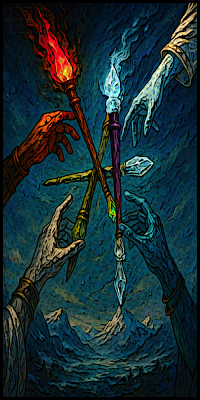
Elemental Soders
Endowed with the Elemental Spirits of Sijinn. Notable Figures & Legends
Inventor of the Soder
Though much isn't known, the person credited through Divination and myth as the creator of the Soder was Aunale' of Talasi. While the Sijinn pursued the shape of Runes, Aunale' preferred different tools than the common implements of the Time. Instead, she isolated herself in a cavern of ice, where she crafted her Soder unwittingly with a piece of Magical Blue Ice. Legends claim that Aunale's specific Blue Ice Soder is capable of restoring broken Ice Artifacts or Relics. It went on to shape the intial letters and syllables of the Talasi language, carved in Ice Runes.
Of Four Elements
This Article discusses the Cultural variation of the Sijinn Tribes and their Elemental legacies.

"Circle of Convergence"
"A recreation of an Izeqorin cave painting."
Culture
4 Worlds
Homeland:
Izeiqor
4 Tribes
Pantheon:
Elemental
Eithon
Ornosi:
Bothon
Fuuthon
Talasi:
Deithon
Lineage
The Fire Kin
Exodus
Homeland:
TBD
Fire
Geography:
Warm Climate
Flame Star
Recognition:
Fire-Walking
Meritocratic
Speech:
Ashen Script
The Earth Kin
Exodus
Homeland:
TBD
Earth
Geography:
Subterranne
Earth Star
Recognition:
Rock-Climbing
Matriarchal
Speech:
Orren Script
The Wind Kin
Exodus
Homeland:
TBD
Wind
Geography:
High Altitudes
Wind Star
Recognition:
Free-Falling
Speech:
Brihun Script
The Water-Kin
Exodus
Homeland:
TBD
Water
Geography:
Tidal Regions
Water Star
Recognition:
Ice-Swimming
Monarchy
Speech:
Thalas Script
Languages
Root Language:
Sijiqon.
Ancient interpretive expressions, with vocalizations and sign language. Magical quality.
Cultural Languages:
Geo's Tongue
Four languages evolved from Sijiqon.Ashasi. Ashen.
Ornosi. Orren.Rihusi. Brihun.
Talasi. Thalas.Fusions of Sijiqon and Leyman's.
Additional Languages:
Leyman's Tongue
A common language spoken through the early Ages and Epochs. Global.
Names
Ashasi Names
Male Ashasi Names
- Arces
- Embral
- Fyrin
- Colan
- Eigol
- Malak
Female Ashasi Names
- Eindra
- Flamesh
- Fyrna
- Miratha
- Sazira
- Scacheth
Ornosi Names
Male Ornosi Names
- Boldo
- Durum
- Urol
- Kobel
- Mudro
- Ombad
Female Ornosi Names
- Eshoya
- Gondel
- Oreseta
- Patha
- Sudetra
- Udrinel
Rihusi Names
Male Rihusi Names
- Cazeus
- Fluunn
- Unfedr
- Scykes
- Rihntu
- Zanmun
Female Rihusi Names
- Aivuun
- Elair
- Teyra
- Halyn
- Wendi
- Zephra
Talasi Names
Male Talasi Names
- Darynch
- Falud
- Heilvor
- Reindra
- Torren
- Waltr
Female Talasi Names
- Aseiri
- Elores
- Merina
- Miratha
- Serine
- Tassa
Favored Classes
Casting Class
Combat Class
Favored Covert Class
References
Mentioned Articles
Myth
Technology
Related Articles
Languages
Sijiqon.
Ancient interpretive expressions, with vocalizations and sign language. Magical quality.
Cultural Languages:
Geo's Tongue
Four languages evolved from Sijiqon.
Ornosi. Orren.
Talasi. Thalas.
Additional Languages:
Leyman's Tongue
A common language spoken through the early Ages and Epochs. Global.
Ashasi Names
Male Ashasi Names
- Arces
- Embral
- Fyrin
- Colan
- Eigol
- Malak
Female Ashasi Names
- Eindra
- Flamesh
- Fyrna
- Miratha
- Sazira
- Scacheth
Ornosi Names
Male Ornosi Names
- Boldo
- Durum
- Urol
- Kobel
- Mudro
- Ombad
Female Ornosi Names
- Eshoya
- Gondel
- Oreseta
- Patha
- Sudetra
- Udrinel
Rihusi Names
Male Rihusi Names
- Cazeus
- Fluunn
- Unfedr
- Scykes
- Rihntu
- Zanmun
Female Rihusi Names
- Aivuun
- Elair
- Teyra
- Halyn
- Wendi
- Zephra
Talasi Names
Male Talasi Names
- Darynch
- Falud
- Heilvor
- Reindra
- Torren
- Waltr
Female Talasi Names
- Aseiri
- Elores
- Merina
- Miratha
- Serine
- Tassa
Related Articles
Arc Sagas' universe and the Arx-Core D10's System (TTRPG) are © Myth-X, 2023–2025. AI assets generated via perchance.org or Elara-AI; all AI Images edited, watermarked by Myth-X. Iconography sourced from RPG-Awesome or Font Awesome. Content is hosted and displayed via World Anvil.
All rights reserved. Redistribution or commercial use without express permission is prohibited.



Wow, it's incredible. It was clear you struck a chord with me. I love this ethnic group and would love to get to know all the tribes. You've packed in so many wonderful and inspiring details that it's impossible to take it all in the first time. Thank you for the fantastic article.
Here are my Entries for the water continent Ulűri̋qi̋
I don't know how to admit the pride I feel receiving such high praise. If I can give the Sijinn even a breath of the Life you've given the Cultures of Elaqitan, I'll consider that successful. Your work and Elemental Cultures are an inspiration. Thank you, Blue Fairy ^^
That's sweet, but believe me, this article is sooo much better than my ethnic groups. I really still have a lot of work to do on that. Still, I'm glad I could inspire you too ;).
Here are my Entries for the water continent Ulűri̋qi̋